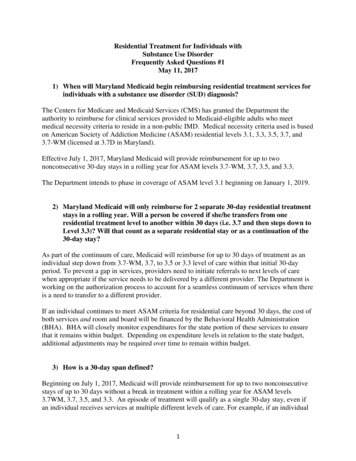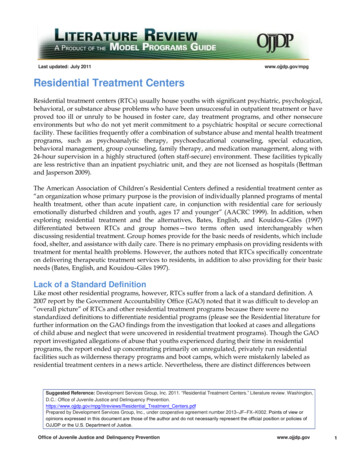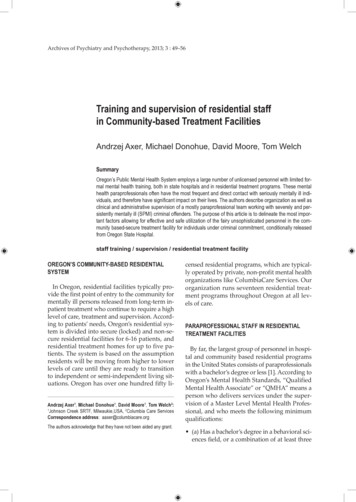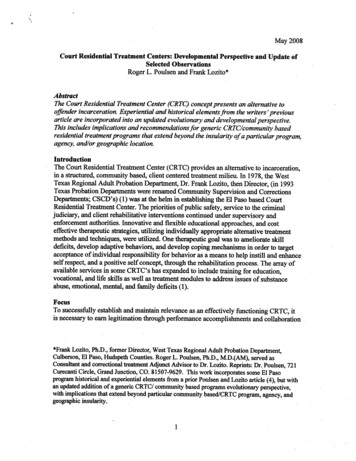
Transcription
Residential Treatment for Individuals withSubstance Use DisorderFrequently Asked Questions #1May 11, 20171) When will Maryland Medicaid begin reimbursing residential treatment services forindividuals with a substance use disorder (SUD) diagnosis?The Centers for Medicare and Medicaid Services (CMS) has granted the Department theauthority to reimburse for clinical services provided to Medicaid-eligible adults who meetmedical necessity criteria to reside in a non-public IMD. Medical necessity criteria used is basedon American Society of Addiction Medicine (ASAM) residential levels 3.1, 3.3, 3.5, 3.7, and3.7-WM (licensed at 3.7D in Maryland).Effective July 1, 2017, Maryland Medicaid will provide reimbursement for up to twononconsecutive 30-day stays in a rolling year for ASAM levels 3.7-WM, 3.7, 3.5, and 3.3.The Department intends to phase in coverage of ASAM level 3.1 beginning on January 1, 2019.2) Maryland Medicaid will only reimburse for 2 separate 30-day residential treatmentstays in a rolling year. Will a person be covered if she/he transfers from oneresidential treatment level to another within 30 days (i.e. 3.7 and then steps down toLevel 3.3)? Will that count as a separate residential stay or as a continuation of the30-day stay?As part of the continuum of care, Medicaid will reimburse for up to 30 days of treatment as anindividual step down from 3.7-WM, 3.7, to 3.5 or 3.3 level of care within that initial 30-dayperiod. To prevent a gap in services, providers need to initiate referrals to next levels of carewhen appropriate if the service needs to be delivered by a different provider. The Department isworking on the authorization process to account for a seamless continuum of services when thereis a need to transfer to a different provider.If an individual continues to meet ASAM criteria for residential care beyond 30 days, the cost ofboth services and room and board will be financed by the Behavioral Health Administration(BHA). BHA will closely monitor expenditures for the state portion of these services to ensurethat it remains within budget. Depending on expenditure levels in relation to the state budget,additional adjustments may be required over time to remain within budget.3) How is a 30-day span defined?Beginning on July 1, 2017, Medicaid will provide reimbursement for up to two nonconsecutivestays of up to 30 days without a break in treatment within a rolling year for ASAM levels3.7WM, 3.7, 3.5, and 3.3. An episode of treatment will qualify as a single 30-day stay, even ifan individual receives services at multiple different levels of care. For example, if an individual1
requires 14 days of care at an ASAM Level 3.7 and then steps down to 14 days of care at anASAM Level 3.3 or 3.5 without a gap in care, the full 28 days of treatment services would bepaid for by Medicaid.For each level of care, ASAM (medical necessity criteria) must be met. Transitions to lowerlevels of care should be considered beginning on the first day of residential SUD service entry.Maryland is invested in a robust continuum of services with the goal of moving individuals fromhigher levels of care to addressing their needs within the community outpatient setting.Administrative days under the Medicaid span may be used if there is a gap in access to the nextlevel of care and these days’ count within the 30-day span of treatment.4) For patients who exceed the 30-day limit and will need to use state grant funds topay for ongoing residential treatment, will the authorizations still come from Beaconor will they come from BHA?Continued Authorization approvals and denials will come through Beacon. If approved, theservices will be paid through the Fee-For-Service system using state funds.5) If an individual requires more than 30 days of treatment, will they be dischargedfrom treatment when Medicaid coverage for the cost of services expires?The system will be set up so that treatment is based on ASAM criteria. At launch of the newsystem on July 1, 2017, state funds will be available to pay for the state-funded portion of thecosts so long as ASAM criteria are met. BHA will closely monitor expenditures as time goes onto determine if additional adjustments are required to remain within budget.6) Can providers seek payment for new services/locations not currently funded bygrant funding?To be eligible to deliver this service, providers must be licensed by OHCQ and enrolled withMedicaid as a Provider Type 54. The Department recently released information related to theapplication process. The application link is -Enrollment.aspx .7) Will there be funds available to help providers make the transition from grantbased funding to Fee-For-Service reimbursement?The Department is working to identify funds to help with the transition.2
8) Will there be technical assistance available to help providers make the transition tobilling in a Fee-For-Service environment?Technical assistance will be made available to providers as we implement these services.Additional information and trainings will be announced soon.9) Will there be state funds available to cover room and board as well as stays meetingASAM criteria beyond the two 30 day spans for new services/providers?At the July 1, 2017 launch, state funds will be available for both of these costs. BHA willclosely monitor the budget after launch to determine if additional funds are needed and/or ifadjustments will be required for the state portion of these costs.10) What will the reimbursement rate be for providers for the provision of services?Will the rates for Medicaid and state-funded services be the same?Medicaid will reimburse for 2 separate up to 30-day residential treatment stays in a rolling year.Medicaid reimbursement rates will be as follows for the different levels of care:(1) For ASAM Level 3.3 the program shall receive a per diem of 189.44(2) For ASAM Level 3.5 the program shall receive a per diem of 189.44(3) For ASAM level 3.7 the program shall receive a per diem of 291.65(4) For ASAM Level 3.7-WM the program shall receive a per diem of 354.67The cost of room and board is not eligible for reimbursement through the Medicaid Program. The state-funded reimbursement rate for room and board will be 45.84 per diem. Statefunds will be available to pay for room and board costs so long as ASAM criteria are met.If an individual continues to meet ASAM for residential care beyond 30 days or requiresmore than 2 30-day stays in a rolling year, the cost of both services and room and boardwill be financed by BHA at the rates described above. If an individual is not eligible for Medicaid and receives state-funded care, the cost ofboth services and room and board will be financed by BHA at the rates described above.BHA will closely monitor expenditures for the state portion of these services to ensurethat it remains within budget. Depending on expenditure levels in relation to the statebudget, additional adjustments may be required over time to remain within budget. There will be a separate Medicaid billing code required for clinical services and aseparate state funded billing code for “room and board”, however both codes will be on3
the same claim. Expenditures paid through state funds will be monitored closely by thestate. BHA will provide advance notification of any changes. The ASO will be providingtraining during the month of June, prior to go-live which will cover authorization processand claims submissions. Rates described above are all inclusive, per diem. Providers are not permitted to balancebill individuals receiving residential SUD services regardless of coverage under Medicaidor BHA financed services.**Additional guidance and opportunities for training will be available in the weekspreceding and post go-live.4
Frequently Asked Questions (FAQ)Residential Treatment for Individuals with Substance Use DisorderLast Updated: 5/25/2017The following answers to frequently asked questions are intended to offer clarification for providers whoare interested in providing residential treatment services to adults with substance use disorders.1. What is ASAM?Founded in 1954, the American Society of Addiction Medicine (ASAM) is a professional societyrepresenting over 3,600 physicians, clinicians and associated professionals in the field of addictionmedicine. ASAM is dedicated to increasing access and improving the quality of addiction treatment,educating physicians and the public, supporting research and prevention, and promoting the appropriaterole of physicians in the care of patients with addiction.2. What is the ASAM Criteria?ASAM’s criteria, formerly known as the ASAM patient placement criteria, is the result of a collaborationthat began in the 1980s to define one national set of criteria for providing outcome-orientated and resultsbased care in the treatment of addiction. The ASAM criteria is the most widely used and comprehensiveset of guidelines for placement, continued stay and transfer/discharge of patients with addiction and cooccurring conditions.3. What are the levels of care reimbursable by Medicaid in Maryland?Maryland Medicaid reimburses for the following levels of care*: Level 3.3 – A residential medium intensity program that provides services in a structuredenvironment in combination with medium-intensity treatment and ancillary services to supportand promote recovery for 20 to 35 hours weekly.Level 3.5 – A residential high intensity program that provides services in a highly-structuredenvironment, in combination with moderate- to high-intensity treatment and ancillary services tosupport and promote recovery for a minimum of 36 hours weekly.Level 3.7 – A residential intensive program that provides a planned regimen of 24-hourprofessionally directed evaluation, care, and treatment in an inpatient setting.Level 3.7-WM – A withdrawal management service that offers 24-hour medically supervisedevaluation and withdrawal management.*Level 3.1 is not covered by Maryland Medicaid. Level 3.1 services are covered through statefunds only.4. What is the process to be certified as an adult residential SUD provider?The program must obtain licensure for the levels of care they are qualified to provide from the Office ofHealth Care Quality.
5. How can I enroll in Medicaid and be reimbursed for my services?Providers are required to apply as a Provider Type 54. To access the PT 54 Medicaid application x.In order to complete the Medicaid application you will need:a. An Office of Health Care Quality (OHCQ) license for each ASAM level of care you provide.b. A copy of your facility’s/ organization’s NPI printout from the National Plan and ProviderEnumeration System (NPPES). One NPI is required for each location. For more informationabout NPI number or to apply for a number, please visit the NPPES website here:https://nppes.cms.hhs.gov/NPPES/Welcome.do.6. What if I am already enrolled as an ICF-A for children (Provider Type 55)?Provider type 55s (residential services for under 21 year olds) who do not provide services to individuals22 years or older do not need to enroll as a provider type 54.If you would like to enroll to be reimbursed for services provided to adults, please follow the instructionson the residential SUD treatment for adults .aspx) toenroll as a provider type 54 (Residential SUD for Adults) with a separate MA/NPI from your providertype 55.7. Can a residential treatment program be eligible to deliver more than one ASAM level of care?Yes, a facility can offer multiple ASAM levels of care. Each level of care will need to be licensed byOHCQ and abide by the regulations set forth in COMAR 10.09.06 and 10.63.8. Does a facility need a separate MA/NPI number for each ASAM level of care?No, a facility only needs one MA/NPI number. But each facility needs one MA/ NPI number per serviceper location. For example, if have a Provider Type 50 at the same location, you will need an additionalMA/ NPI number for a Provider Type 54.9. Can a patient continue to receive methadone while in residential care?Yes. The weekly administrative fee (H0020 – HG) for Opioid Treatment Programs (OTPs) includes thecost of delivering Methadone from the OTP to participants in residential settings. The OTP can continueto be reimbursed for the administrative level of service while the patient is receiving care in a residentialsetting.10. Will buprenorphine induction and/ or maintenance be a separately billed service?No. The rate for an Adult residential SUD service is all inclusive. The exception to this is if a patient isreceiving buprenorphine maintenance from an OTP, the OTP can continue to be reimbursed for the
administration level of service while the patient is receiving care in a residential setting. Theadministrative fee includes the cost of delivery for medications from the OTP to the SUD residentialsetting.11. Can providers balance bill individuals who are enrolled in Medicaid or who receive statefunded services?Providers are never permitted to balance bill Medicaid recipients for covered services. Providers are alsonot permitted to balance bill individuals who receive state-funded services financed by BHA.12. Why are Level 3.3 and Level 3.5 being reimbursed at the same rate?While there are fewer clinical services at level 3.3 versus level 3.5, there is a medical component that isincluded in level 3.3. The identical rate is a reflection of the service shift from higher level of clinicalneed to higher level of medical need.
Residential Substance Use DisorderTreatment for AdultsFrequently Asked Questions # 3June 9, 20171. My program has submitted an application to OHCQ for a license and was told it would not beprocessed until July 1st.There is a difference between being licensed by OHCQ (under COMAR 10.63) and certified byOHCQ (under COMAR 10.47). Medicaid will accept OHCQ licenses and/ or certifications duringthe implementation of the Residential SUD for Adults benefit.2. Where can I find the list of Evidence-Based Practices (EBPs) that are required for enrollment?The Medicaid provider application can be found px.The EBPs are listed on page 3 of the attestation (page 26 of the document). Providers should include abrief description of each EBP they attest to as well as a description of training and supervision of staffrelated to the EBP.3. What are the minimum hour requirements per week for the recovery coach?Please see the most up to date version of the proposed regulations px.The requirement for a recovery coach has been amended to state that aftercare coordination servicesmay be provided by a peer support specialist or licensed clinician. The regulations do not specifyweekly hour requirements.4. ASAM level 3.5 is a more intensive level of care than 3.3, yet the staffing requirements areless. Why is this?A typical participant receiving ASAM Level 3.3 services has an addictive disorder that is so severe ithas resulted in significant temporary or permanent cognitive impairment. Treating the cognitiveimpairment and associated medical conditions requires additional medical services that are notnecessary for participants receiving ASAM Level 3.5. Clinical services tend to be less beneficial forparticipants receiving Level 3.3 than for the typical participant receiving Level 3.5 and therefore lessclinical staff and more medical therapeutic support would be appropriate at Level 3.3.5. What are the minimum duties of the physician/CRNP? Of the psychiatrist or CRNP psych? Ofthe recovery coach?
Information on required services and staffing can be found in the proposed regulations px.Providers requiring additional assistance should request technical assistance from BHA by email totrina.ja’far@maryland.gov.6. What plans have been made to account for possible implementation glitches during the initialtransition period?The Department and Beacon Health Options are working closely with providers to ensure they areprepared for the July 1, 2017 implementation date.Maryland Medicaid is placing a priority on enrolling Residential SUD for Adults programs. Allprograms who submit a complete application before Jun 26, 2017 will be able to receiveauthorizations for July 1, 2017. For more information on the provider enrolment process please seethe Res SUD for Adults webpage here: con is providing regional trainings across the state over the next few weeks that focus onresidential ASAM, authorizations, and claims. For more information see the provider alerts der/prv alerts.html. Beacon will also be providingadditional training through webinars with a focus on authorizations and the ProviderConnect system.Sign up for provider alerts by emailing mdproviderrelations@beaconhealthoptions.com to receiveinformation as it is released. Beacon also provides one-on-one trainings with providers who areunfamiliar with billing fee for service or have not submitted authorizations through Beaconpreviously. Providers who have questions may contact provider relations at 800-888-1965 or atmdproviderrelations@beaconhealthoptions.com.The Behavioral Health Administration is offering technical assistance for Residential SUD for Adultsproviders upon request. For additional information please email trina.ja’far@maryland.gov for a TArequest form.7. There is a holiday within the first week of implementation. Holidays historically delaypayments. What accommodations could be made to account for this holiday falling within thefirst few days of the transition?Providers should continue to submit claims as usual despite the weekend and holiday falling at thetime of transition. Beacon will issue payment on schedule with our customary cycle ofreimbursement, however due to a holiday falling on Tuesday July 4th, Beacon Health Options will becompleting the check run on Monday July 3rd. A Provider Alert will be issued specifically regardingthis issue.8. Will there be real time supports available to assist providers during the period of transition?
Providers with questions/ issues regarding authorizations or billing may contact provider relations at800-888-1965 or at mdproviderrelations@beaconhealthoptions.com.BHA, Medicaid, and Beacon will be implementing a Joint Operations Team for post implementation.Providers will send questions/ issues to the JOT and answers will be provided during a weekly callthat will include representatives of the provider community. More information on this process willcome out through provider alert in the coming weeks.9. What will happen with the participants who are currently in residential beds on July 1, 2017?Programs that have enrolled with Medicaid as a Provider Type 54 who have participants in their careas of July 1st must ensure that they have supplied Beacon with all information for determination ofmedical necessity. This determination is an authorization which needs to be in place as of July 1st forthose in care who will be continuing in care. Beacon Health Options will be releasing additionalinstructions through provider alerts and webinar trainings on when providers may begin submittingauthorizations for participants who are currently receiving services.10. What is the estimated time processing authorization? Originally we heard authorizations wouldtake 14 days to get for new clients, now we are hearing 3 days. Which is accurate?For ASAM levels 3.7 and 3.7WM, reviews for medical necessity are made at the time of the call. Forall other non-urgent levels of care requested online in ProviderConnect, almost all determinations aremade within the first 3 days with the majority being made within 24 hours. If there is a reason to doan expedited review a provider can telephonically call in the request and Beacon will process it at thetime of the call. Providers are reminded that discharge planning from higher levels of care should beinitiated on day one of admission. Plans to step down care are part of the treatment planning process.11. How soon can a provider request a concurrent authorization?Authorizations should not be submitted so early that the clinical information will not be relevantwhen the service begins. For ASAM level 3.3 and 3.5 most of the time authorizations could besubmitted up to 7 days before the requested dates of service. For ASAM level 3.7 and 3.7WMauthorizations should not be submitted more than a day or two before the requested continuation ofservice dates.12. How many days at a time are authorized?See the chart below for the maximum number of days of authorizations for each level of care undereach authorization request. Please note that providers should submit requests based on clinical need.For example, if a patient requires Level 3.7WM for 5 days, the provider should request 5 days, not themaximum of 7 days.ASAM LevelInitialAuthorizationConcurrentAuthorizations
Level 3.3Level 3.5Level 3.7Level 3.7WMUp to 30 daysUp to 30 daysUp to 15 daysUp to 7 daysUp to 30 daysUp to 30 daysUp to 15 daysUp to 7 days13. What is the uninsured eligibility criteria for residential services?The provider is required to document and verify the person meets all seven uninsured eligibilitycriteria provided below:1) The individual requires treatment for a behavioral health diagnosis covered by the PublicBehavioral Health System (PBHS);2) Must meet the American Society of Addiction Medicine (ASAM) criteria for the level of care.3) The individual is under 250% of the Federal Poverty Level (FPL) and not covered by Medicaid(MA) or other insurance; Individuals who are dually eligible must be under 500% of FPL.4) The individual has a verifiable Social Security number;5) The individual is a Maryland resident;6) The individual has applied to Medicaid; the Health Care Exchange; Social Security Income (SSI)or Social Security Disability Income (SSDI), if they have an illness/disability for a period of 12months or more); and7) The individual meets the U.S. citizenship requirement.Exceptions to the above requirement may be made by the designated local authority underextenuating circumstances. Should the local behavioral health authority approve the request, then anuninsured eligibility span is established according to the same timeframes indicated in question #12.BHA will collect data on exceptions made to determine if future adjustments to the uninsuredworkflow are indicated.14. If an individual needs residential services for the third time in a rolling year, what happens?Can they receive services?If the individual meets MNC they will be authorized for services. Any stays beyond what isreimbursable by Medicaid will be covered by state only dollars. The process of determining whichsource of funds will be used will be managed by Beacon and will be mostly invisible to providers.15. What will happen in situations when there is a need for a break in care due to a hospitaladmission?Administrative days may be used for individuals admitted to a hospital for a short period of time.These situations will be handled on a case by case basis.16. What will happen if a patient no longer meets MNC for a higher level of care but a bed is notyet available at a lower level?For each level of care, MNC must be met. Transitions to lower levels of care should be consideredbeginning on the first day of residential SUD service entry. Maryland is invested in a robust
continuum of services with the goal of moving individuals from higher levels of care to addressingtheir needs within the community outpatient setting. Administrative days under the Medicaid spanmay be used if there is a gap in access to the next level of care and these days count within the 30-dayspan of treatment under Medicaid.17. Can PT 54s be reimbursed for assessments?The rates for ASAM levels 3.7 WM, 3.7, 3.5, and 3.3 are all inclusive. Based on provider feedback,we will be reviewing this question during the regulations comment period.18. Are mental health services inclusive in the rate or can providers bill separately for mentalhealth services?The rates for ASAM levels 3.7 WM, 3.7, 3.5, and 3.3 include all counseling and therapeutic servicesand include services delivered by licensed therapists who may not be separately reimbursed from theper diem for the program. Services that may be separately reimbursed include visits with apsychiatrist for a co-occurring psychiatric condition, and visits made by opioid treatment providerswho deliver methadone or buprenorphine, to the facility during the patient’s stay. Those OTPs wouldbe reimbursed their weekly medication assisted treatment maintenance rate.19. Will advances be available for small providers who are more dependent on regular and timelyfee for service revenue to meet financial obligations?Beacon operates a customary weekly check disbursement cycle to Providers. Beacon recommendsbilling as frequently as necessary to meet your organization’s financial needs. Beacon will issuepayment on schedule with our cycle of reimbursement. If there are substantially severe extenuatingcircumstances that would require special consideration, please contact Beacon Health Options whowill consult directly with the Department on a case by case basis. Please be aware, Beacon will beproviding continuing Provider training on claims and authorizations submission processes.
Residential Substance Use DisorderTreatment for AdultsFrequently Asked Questions # 4Please note that only providers who have enrolled with Medicaid as aprovider type 54 will be able to obtain authorizations. Please get yourapplications to: mdh.bhenrollment@maryland.gov to initiate this process.Applications received after 6/26 may not be able to obtain authorizations orpayment for services on 7/1/2017.1. Do all services need authorization, for both Medicaid and uninsured populations?Yes, all services need to be authorized by Beacon in order for claims to be reimbursed regardlessof source of funds. Requests for authorization must be submitted prior to treatment. Thisincludes all levels of SUD residential care 3.7 WM, 3.7, 3.5, and 3.3.2. How do we request authorization for SUD Residential treatment?Authorizations can be requested telephonically, or electronically. Telephonic authorizations areinitiated by calling the Beacon customer service line (800-888-1965) & providing clinicalinformation to a licensed Clinical Care Manager in the Clinical Department. Electronicauthorizations are completed by the provider through submission of a request in ProviderConnect. ProviderConnect can be accessed 24/7, including weekends and holidays through theBeacon website: ain.htmlFAQ for 6-16 v1, 6-13
Upon completing the necessary log on information & pulling the member file needed, providerswill select e the Inpatient/HLOC/Specialty drop down option found in the Level of Service fieldto submit for authorization requests.After selecting the appropriate Level of Service, Type of Service, Level of Care, Type of Care &completing each asterisked item, providers will follow the prompts to the next screen.Providers will click on each of the tabs, and complete the asterisked items found in each tab. Theasterisked items are needed to complete the request for authorization.Beacon Health Options has developed a new form to assist providers in reviewing and updatingthe 6 ASAM dimensions. (See attached). Upload the form with the clinical information on the 6ASAM dimensions. The Clinical Care Manager will review the information submitted in therequest, to include the attached form, & will authorize the number of days based upon clinicalneed &ASAM criteria. If unable to upload the attached form, providers can detail rationale forrequest in the narrative text box found under the Current Risk Tab:More detailed information on the authorization submission process & how to upload the attachedform will be discussed at the upcoming provider trainings.FAQ for 6-16 v1, 6-13
3.What is the number of days that will be authorized at one time for each level of care?Level ofCareNumber of Days AuthorizedInitialNumber of Days AuthorizedConcurrent3.7 WMUp to 7 daysUp to 7 days3.7Up to 15 daysUp to 15 days3.5Up to 30 daysUp to 30 days3.3Up to 30 daysUp to 30 daysPlease be aware that the number of days authorized will be based upon ASAM medical necessitycriteria. Authorizations may be less than the maximum number of days based upon casecomplexity.4. How long will it take to get an authorization?Requests made online through the Beacon ProviderConnect system are processed rapidly with themajority being done within 1 day. Beacon is committed to making certain that providers receiveaccurate and timely information on authorizations. Telephonic requests will be processed at thetime of the call. If there is an urgent need for a clinical review, please feel free to call in toprovide the clinical information to Beacon Health Options 24 hours per day at 1-800-888-1965.5. If a program is reimbursed under grant funds for an individual currently, what should bedone if the member is still meeting MNC on 7/1/17?The consumer may remain in treatment if they meet medical necessity criteria. Please submit arequest for authorization to the Beacon system for that consumer with the new start date of 7/1/17for the appropriate level of care. Authorizations will be based upon medical necessity usingASAM criteria. Re
2) Maryland Medicaid will only reimburse for 2 separate 30-day residential treatment stays in a rolling year. Will a person be covered if she/he transfers from one residential treatment level to another within 30 days (i.e. 3.7 and then steps down to Level 3.3)? Will that count as a separate residential stay or as a continuation of the 30-day stay?










